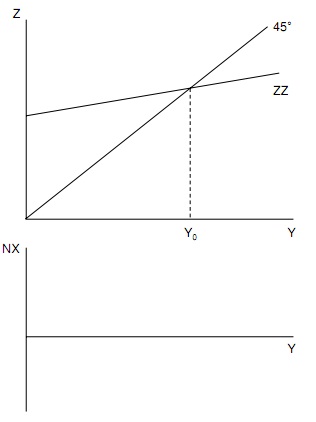Problem 1: Consider the following equations that describe the labor market:
- (The PS equation) P = (1 + �μ)W where P, W, and μ� are the price level, nominal wage, and the �rms's markup over costs, respectively.
- (The WS equation) W = Pe(b - u), where Pe, b and u are the expected price level, unemployment bene�ts, and the unemployment rate, respectively.
(1) Suppose that P = Pe, the markup of prices over costs is 0.1, and the amount of unemployment bene�ts is 1 (b = 1).
(i) Calculate the real wage as determined by the price-setting equation.
(ii) Calculate the natural rate of unemployment?
(2) Suppose that P = Pe, the markup of prices over costs is 0.1, but the amount of unemployment bene�ts increases to 1.1 (b = 1:1).
Calculate the new level of the natural rate of unemployment associated with this higher level of unemployment bene�ts.
Problem 2: The AS relation in year t is given as Pt = Pte [0.8 + Yt/1000]� where Pt, Pte, and Yt are the price level in year t, the expected price level in year t and the output level in year t, respectively. The AD relation in year t is given by Yt = 1300 - 1000Pt. Suppose that P2007e = 1.
(1) Using this information, calculate the natural level of output Yn (Hint: To get Yn, you have to use the condition that Pt = Pte)
(2) Draw the AS relation in 2007. Clearly indicate the value of Yn and the value of P2007e in your diagram.
(3) Carefully add the AD relation to your diagram.
(4) Find the short-run equilibrium level of output in 2007 (Y2007). What is the corresponding level of price in 2007 (P2007)? Clearly indicate the values of Y2007 and P2007 in the diagram you drew in (2).
(5) Is P2007 higher or lower than P2007e? Assuming that Pet+1 = Pt, what will the expected price level in 2008 be? Briefly explain.
(6) Add the AS relation in 2008 to the diagram.
(7) Illustrate the MR equilibrium and indicate the medium-run level of price as PMR. Then calculate PMR.
Problem 3: Start by drawing a typical AS/AD diagram. Suppose that the economy is initially in a medium run equilibrium. In your diagram, clearly label the natural level of output "Yn", the initial level of actual output "Y0" and the expected price level "Poe".
(1) Illustrate the short-run e�ects of a tax cut on the AD and AS curves in your diagram. What e�ects will the tax cut have on output and price in the short run? Label the short-run level of output "Y1" and the short-run level of price "P1" in your diagram.
(2) Illustrate the new medium run equilibrium which will result from the tax policy in your diagram. What e�ects will the tax cut have on output and price in the medium run?
Label the new medium run equilibrium level of price "PMR" in your diagram.
(3) In the short run, will consumption increase or decrease? In the new medium run equilibrium, will the level of consumption be higher or lower than that at the initial medium run equilibrium? Explain your answers.
(4) In the short run, will investment increase or decrease? In the new medium run equilibrium, will the level of investment be higher or lower than that at the initial medium run equilibrium? Explain your answers.
Problem 4: Answer the questions based on the diagram provided below. Please reproduce it in your paper and add any new curve(s) according to the instructions in the following questions.
(1) Suppose that the U.S. economy is initially experiencing a trade de�cit. Carefully draw a NX line that describes this situation.
(2) Further assume that government o�cials would like to eliminate the trade de�cit and adjusting G is the only option they can use. Should they increase or decrease G to eliminate the trade de�cit? What e�ect would this policy have on output? Illustrate your answers in the diagram provided below.

Problem 5: Consider the following model.
C = 100 + 0:6(Y - T) (consumption)
I = 80 (investment)
G = 130 (government spending)
T = 100 (taxes)
X = 0.1Y* - 50� (exports)
IM/ε = 0.1Y + 50ε� + 50 (imports)
Y* �= 3000 (foreign income)
ε = 2 (real exchange rate)
(1) Solve for equilibrium real output Find the equilibrium value of NX. Is this economy running a trade de�cit or surplus? Let us consider four separate scenarios described by (2) (5) below.
(2) Suppose that government wants neither trade de�cit nor trade surplus and the only policy tool to achieve this goal is to adjust its spending G. Should it increase or decrease its spending G? What value of G should the government choose?
(3) Suppose that the economy needs Y = 800 in order to achieve full employment, the government wants to accomplish this full employment level of output and the only policy tool to achieve this goal is to adjust its spending G. Should it increase or decrease its spending G? What value of G should the government choose? If it pursues this policy, what would be the level of net exports?
(4) Suppose that the level of foreign income increased from 3000 to 4000. Solve for equilibrium real output and the equilibrium value of NX. output and the equilibrium value of NX.